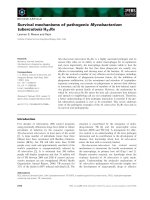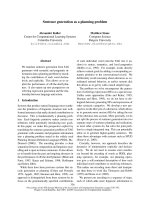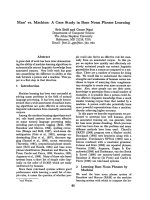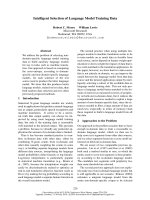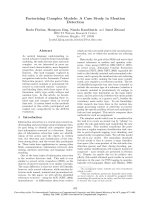báo cáo khoa học: "Laparoscopic myomectomy of a subserous pedunculated fibroid at 14 weeks of pregnancy: a case report" ppt
Bạn đang xem bản rút gọn của tài liệu. Xem và tải ngay bản đầy đủ của tài liệu tại đây (1.03 MB, 19 trang )
This Provisional PDF corresponds to the article as it appeared upon acceptance. Fully formatted
PDF and full text (HTML) versions will be made available soon.
Laparoscopic myomectomy of a subserous pedunculated fibroid at 14 weeks of
pregnancy: a case report
Journal of Medical Case Reports 2011, 5:545 doi:10.1186/1752-1947-5-545
Mario Ardovino ()
Italo Ardovino ()
Maria Antonietta Castaldi ()
Antonietta Monteverde ()
Nicola Colacurci ()
Luigi Cobellis ()
ISSN 1752-1947
Article type Case report
Submission date 26 April 2011
Acceptance date 5 November 2011
Publication date 5 November 2011
Article URL />This peer-reviewed article was published immediately upon acceptance. It can be downloaded,
printed and distributed freely for any purposes (see copyright notice below).
Articles in Journal of Medical Case Reports are listed in PubMed and archived at PubMed Central.
For information about publishing your research in Journal of Medical Case Reports or any BioMed
Central journal, go to
/>For information about other BioMed Central publications go to
/>Journal of Medical Case
Reports
© 2011 Ardovino et al. ; licensee BioMed Central Ltd.
This is an open access article distributed under the terms of the Creative Commons Attribution License ( />which permits unrestricted use, distribution, and reproduction in any medium, provided the original work is properly cited.
Laparoscopic myomectomy of a subserous pedunculated fibroid at 14 weeks of pregnancy:
a case report
Mario Ardovino
1
, Italo Ardovino
2
, Maria Antonietta Castaldi
1*
, Antonietta Monteverde
1
, Nicola
Colacurci
1
and Luigi Cobellis
1
Addresses:
1
Department of Gynaecology, Obstetric and Reproductive Science, Second University
of Studies of Naples, Largo Madonna delle Grazie 1, 80138, Naples, Italy.
2
Operative Unit of
Obstetrics and Gynecology, A.O.R.N. S.G. Moscati, Avellino, Italy.
*Corresponding author
MAC:
Abstract
Introduction: Uterine leiomyomas are seen in 1.6% to 4% of pregnancies. With the increasing age
of obstetric patients, more cases are being encountered during pregnancy.
Case presentation: We report the case of a 31–year–old Caucasian woman with acute recurrent
abdominal pain due to a subserous fundic myoma, measuring 48x52x63mm, with an implantation
base of 22x18mm, which was successfully treated by laparoscopy at 14 weeks of pregnancy. At a
gestational age of week 40, the patient spontaneously delivered a healthy 3216g girl baby.
Conclusion: As far as we know, this is the first reported case of laparoscopic myomectomy this
early during a pregnancy. Our experience together with an analysis of cases reported in the
literature suggests that myomectomy during pregnancy may be considered safe, but only in the
hands of experienced laparoscopic surgeons. There are a few reports in the literature about
laparoscopic myomectomy during the first half of pregnancy that demonstrate its feasibility in
selected cases. Some technical tools could improve the procedure with a minimum of risk for the
ongoing pregnancy.
Introduction
Uterine leiomyomas are seen in 1.6% to 4% of pregnancies. With the increasing age of obstetric
patients, more cases are being encountered during pregnancy. The effect of leiomyomas on
pregnancy depends on their number, size and location. Myomectomy is generally avoided during
pregnancy because increased vascularity can lead to hemorrhagic complications that may
necessitate hysterectomy, but it is indicated in some situations [1–3]. Indications for myomectomy
during pregnancy include severe abdominal pain due to torsion of subserous pedunculated
myomas or red degeneration not responding to medical treatment, and an increase in myoma size
causing abdominal discomfort [4, 5].
There are a few reports in the literature about laparoscopic myomectomy during the first half of
pregnancy that demonstrate its feasibility in selected cases [1, 6-10]. However, laparoscopic
myomectomy can be considered a minimally invasive alternative to the traditional laparotomy
during pregnancy, resulting in less postoperative pain and a shorter recovery time [3].
We report a case of acute recurrent abdominal pain due a subserous fundic myoma that was
treated by laparoscopy at 14 weeks of pregnancy. Additionally, we examine some technical
surgical aspects and devices, and review the international literature.
Case Presentation
A 31-year-old, Caucasian primigravid woman was referred to our attention at 14 weeks of
gestation because of acute recurrent abdominal pain localized in the right periumbilical region and
not responsive to analgesic therapy. On admission she was 165cm height, 65kg weight with a body
mass index (BMI) of 23.5. She had no fever and a normal white blood cell count.
At pelvic examination the uterus appeared bigger than expected for gestational age and irregular.
A trans-abdominal sonographic scan showed the presence of an intrauterine singleton pregnancy
corresponding to gestation date and a subserous fundic myoma, measuring 48x52x63mm, with an
implantation base of 22x18mm. No other ultrasonographic sign related to the symptoms such as
hemoperitoneum or area of degeneration in the myoma was observed. She received paracetamol
and tramadol, without relief. As the acute abdominal pain symptoms suggested a possible torsion
of the myoma, laparoscopic surgery was performed under general anaesthesia.
Pneumoperitoneum was achieved by infra–umbilical Veress needle until an intra–abdominal
pressure of 10 mmHg was reached. The first trocar was introduced transumbilically. Intra–
abdominal visualization, obtained with a 10 –mm, 0–degree, high definition telescope, showed an
enlarged, irregular uterus with a subserous myoma, with an implantation base localized in the
fundic right lateral region, with a consistent adherence to the anterior abdominal wall (Figure 1).
The adnexa, round ligaments, appendix, and gallbladder were regular. Under laparoscopic vision
two 5mm ancillary trocars were positioned in the right and left pelvic region, 2cm above and 1cm
medial to the anterior superior iliac spine. The adherence was carefully removed and separated
from the myoma with gentle maneuvers. The base of the myoma was identified and strangled
with a Monocryl–1, no–needle suture performed with an extracorporeal technique. After waiting
for the myoma ischemia, the myoma was enucleated by a bipolar electrosurgical device (PKS
Plasmaspatula, Gyrus Medical Inc, Minneapolis, MN), leaving minimal residual tissue (Figure 2,
Figure 3 and Figure 4). At this point a 3–mm, 0–degree, high definition telescope was introduced in
the left 5–mm trocar and the umbilical trocar was replaced with a Rotocut G1 tissue morcellator
(Karl Storz GmbH & Co. KG, Tuttlingen, Germany). The entire myoma was removed from the
abdominal cavity by transumbilical morcellation. Blood loss was 30mL and came only from the
myoma. The surgical laparoscopic breaches were closed with biological surgical glue (Glubran 2–
synthetic surgical glue, GEM S.r.l., Viareggio, Italy). The operation lasted for 39 minutes. Fetal
heart monitoring was regular pre- and post-operatively. No intra- or post–operative complications
occurred, and she was discharged after three days.
Definitive pathologic examination confirmed the diagnosis of a myoma weighing 127g. At
gestational age week 40, she spontaneously delivered a healthy baby girl weighing 3216g.
Discussion
This is the first reported case of laparoscopic myomectomy during such an early time of pregnancy
(14 weeks) that we could find in the literature. Although the myoma was quite big (127g), its
position (fundic right lateral region) let us easily complete the intervention. Although
postoperative adhesion development after laparoscopic myomectomy has been described in the
literature and in our patient the source of pain was the adhesion, simple adhesiolysis was not
contemplated. We decided to perform a complete myomectomy to eliminate the risk of red
degeneration and necrosis during the ongoing pregnancy [4, 5]. We also decided not to apply an
adhesion barrier over the surgical site, since data presented in the literature are still not
conclusive, even if they show an encouraging safety profile [11].
Uterine myomas are the most frequent gynecological tumors and they are seen in 1.6% to 4% of
pregnancies. Most myomas remain asymptomatic during pregnancy. Routine ultrasonography
performed at this time improves the detection of these lesions and the evaluation of any possible
complications. Such complications comprise spontaneous abortion, antepartum bleeding,
premature rupture of membranes, preterm labor, placenta previa, post-partum bleeding and a
high incidence of Caesarean deliveries [2].
Although controversy persists among reports of myomectomy being performed during pregnancy,
there are specific clinical conditions that require this surgical procedure. These include severe
abdominal pain due to torsion of subserous pedunculated myomas or red degeneration not
responding to medical treatment, and an increase in myoma size causing abdominal discomfort [2,
4].
Although myomectomy during pregnancy may lead to abortion, fetal acidosis and hemorrhage, we are
aware of no available published cases of post-operative abortion or fetal acidosis during laparoscopic
myomectomy [2, 3]. Hemorrhage is the first complication of laparoscopic myomectomy. Although
there is a high incidence of blood loss during myomectomy, there are no reported cases of
conversion to open surgery or surgical delivery related to myoma resulting in uncontrolled
bleeding during laparoscopy [4, 5].
Although a laparoscopic approach for uterine myomas during pregnancy is rarely described, our
experience suggests that uterine myomas can be easily managed laparoscopically by an
experienced surgeon in selected cases, depending on size, type and position of the fibroids.
A MEDLINE and EMBASE search revealed six case reports of laparoscopic myomectomy during
pregnancy from 1994 to 2011, carried out in the second half of pregnancy between 16 and 25
weeks of gestation (Table 1) [1, 6–10]. All the procedures were performed for acute abdominal
pain, and in five cases pregnancy ended with spontaneous delivery, while only one case
underwent preterm delivery (caesarean section) because septic necrosis of the myometrium
occurred [8].
The main issues regarding laparoscopic myomectomy during pregnancy were found to be the
following: entry, pneumoperitoneum, electricity, uterine mobilization and myoma morcellation.
Initial access can be safely accomplished with an open (Hasson), Veress needle or optical trocar
technique if the location is adjusted according to fundal height, previous incisions, and experience
of the surgeon (Level III). There has been much debate regarding abdominal access in the pregnant
patient with preferences toward either an open technique or Veress needle. The concern for using
the Veress needle technique has largely been based on concerns about the higher likelihood of
injury to the uterus or other intra-abdominal organs as fundal height increases [3]. If the site of
initial abdominal access is adjusted according to fundal height and the abdominal wall is elevated
during insertion, both the Hasson technique and the Veress needle can be safely and effectively
utilized [3].
In all the reported cases the entry was performed by an open technique and the site of entry
chosen according to fundal height [1, 6–10].
Our case is the first report of an uncomplicated entry performed with the classic Veress needle
technique. Our choice was determined by two main factors: the first one is that there was a low
risk of uterine damage, since the 14-week uterine fundus raised the hypogastrium, being 4cm
under the umbilical scar. The second reason was the fact that the myoma was situated in the right
iliac fossa, thus avoiding any injury during the entry [3].
The second main issue is pneumoperitoneum induction, as the pneumoperitoneum using CO
2
may
irritate the uterine tissues and increase the risk of acidosis to the fetus.
The potential effects of CO
2
insufflation on the pregnant patient and her fetus have led to
apprehension over its use. The pulmonary effects of pneumoperitoneum in the pregnant patient
and the potential risk for acidosis to the fetus have caused concern and have led some
investigators to develop alternative approaches of gasless laparoscopy [6] but in only one case was
a gasless surgery performed [6]. In our case the insufflation pressure was set at 10mmHg from the
beginning of the intervention. In our 20 years of laparoscopic experience this reduces
postoperative pain, and in our case this method lowered the potential effects of CO
2
insufflation
on the patient and her fetus, with a decreased acidosis and abortion risk [3]. Fetal acidosis and
associated fetal instability in CO
2
pneumoperitoneum have been documented in animal studies,
although no long-term effects from these changes have been identified [3, 12]. Fetal acidosis with
insufflation has not been documented in the human fetus, but concerns over potential
detrimental effects of acidosis have led to the recommendation of maternal CO
2
monitoring [3,
12]. Initially, there was debate over maternal blood gas monitoring of arterial carbon dioxide
(PaCO
2
) versus end-tidal carbon dioxide (EtCO
2
) monitoring, but the less invasive capnography has
been demonstrated to reflect maternal acid/base status adequately in humans [3, 12]. Several
large studies have documented the safety and efficacy of EtCO
2
measurements in pregnant
women [3] making routine blood gas monitoring unnecessary [12].
Electricity is needed during a laparoscopic myomectomy in order to gain an optimum hemostasis.
In case of myomectomy during pregnancy all the authors agree on the use of bipolar electricity to
minimize any possible injury to the fetus [1, 6-10]. In our case, after positioning a Monocryl 1 no-
needle suture, we enucleated the myoma with the bipolar Plasmaspatula, thus avoiding sparking
phenomena associated with monopolar energy sources that may endanger the fetus or displaced
bowel [3, 10]. This is a bipolar electrosurgical device designed to deliver high current and very low
voltage to tissue. Tissue impedance is continuously monitored by the instrument, and energy
delivery is adjusted accordingly. This system delivers electrosurgical energy through a series of
rapid pulses, thereby allowing the tissue to cool briefly and limiting the heating of adjacent tissue.
Protein in the vessel walls is denatured and forms a coagulum, which occludes the lumen [13].
Therefore, the cut of the myoma was at the level of the large base right up the suture. The
minimum residual tissue of the myoma became completely ischemic, thus avoiding any problem
for the patient. This method of removing the myoma lets the surgeon cut far away from the
myometrium, thus avoiding a possible uterine contraction, with consequent high risk for abortion.
Uterine mobilization may represent a challenge for the surgeon, as it is not possible to use a
uterine manipulator during pregnancy. The size of the myoma itself could also represent another
challenge. The largest myoma removed by laparoscopy weighed 1500g [7].
Myoma morcellation may lead to severe uterine damage, which could be harmful for the ongoing
pregnancy. A transumbilical morcellation is described in only one of the reported cases [7];
indeed, transumbilical morcellation is well described in laparoscopic gynecological surgery. The
present morcellation technique, performed by using a 3mm, 10 degree telescope introduced in
the left 5mm trocar, lets the surgeon take a comfortable position, and, in addition, this method
keeps the morcellator blade far away from the gravid uterus. This is a clear advantage in the
situation of pregnancy, where it is impossible to manipulate the uterus. Additionally, the telescope
introduced in the left 5mm trocar allows optimal spatial vision.
In the end, the use of a mininvasive technique with two 5mm ancillary trocars resulted in minimal
damage to the abdominal organs and a high aesthetic acceptability. In our recent experience the
use of two 5mm ancillary trocars for laparoscopic myomectomy is a good approach for the
surgeon and has a high aesthetic acceptability for the woman. It lets the surgeon work without
particular problems and allows the easy use of either extra- or intra-corporeal knots.
Conclusion
Our experience, together with the analysis of literature, suggests that laparoscopic myomectomy
during pregnancy may be considered safe in selected cases, even in an early stage, but only in the
hands of experienced laparoscopic surgeons.
Safety and pregnancy risk cannot be concluded on the basis of six case reports, only five of which
have pregnancy outcome data. Further investigations are needed to improve and better define
safety and feasibility of laparoscopic myomectomy during pregnancy.
Consent
Written informed consent was obtained from the patient for publication of this case report and
any accompanying images. A copy of the written consent is available for review by the Editor-in-
Chief of this journal.
Competing interests
The authors declare that they have no competing interests.
Authors’ contribution
MA contributed to the paper as surgeon, in the conception of the manuscript, data collection and
critical discussion. IA contributed to the paper as surgeon, in the conception of the manuscript, in
data analysis, interpretation and critical discussion. MAC contributed to the paper in the
conception and drafting of the manuscript, in data analysis, interpretation and critical discussion.
AM contributed to the paper in the analysis of the manuscript, data interpretation and critical
discussion. NC contributed to the paper in the conception of the manuscript, data analysis and
critical discussion. LC contributed to the paper as surgeon, in the conception of the manuscript, in
data analysis, interpretation and critical discussion. All authors read and approved the final
manuscript.
References
1. Fanfani F, Rossitto C, Fagotti A, Rosati P, Gallotta V, Scambia G: Laparoscopic myomectomy
at 25 weeks of pregnancy: case report. J Minim Invasive Gynecol 2010,17:91-93.
2. Lolis DE, Kalantaridou SN, Makrydimas G, Sotiriadis A, Navrozoglou I, Zikopoulos K,
Paraskevaidis EA: Successful myomectomy during pregnancy. Hum Reprod 2003, 18:1699-
1702.
3. Guidelines Committee of the Society of American Gastrointestinal and Endoscopic
Surgeons, Yumi H: Guidelines for diagnosis, treatment, and use of laparoscopy for surgical
problems during pregnancy. Surg Endosc 2008, 22:849-861.
4. Bonito M, Gulemì L, Basili R, Roselli D: Myomectomy during the first and second trimester
of pregnancy. Clin Exp Obstet Gynecol 2007, 34:149-150.
5. Agdi M, Tulandi T: Minimally invasive approach for myomectomy. Semin Reprod Med
2010, 28:228-234.
6. Melgrati L, Damiani A, Franzoni G, Marziali M, Sesti F: Isobaric (gasless) laparoscopic
myomectomy during pregnancy. J Minim Invasive Gynecol 2005, 12:379-381.
7. Pelosi MA, Pelosi MA, Giblin S: Laparoscopic removal of a 1500g syptomatic myoma
during the second trimester of pregnancy. J Am Assoc Gynecol Laparosc 1995, 2:457-462.
8. Sentilhes L, Sergent F, Verspyck E, Gravier A, Roman H, Marpeau L: Laparoscopic
myomectomy during pregnancy resulting in septic necrosis of the myometrium. BJOG.
2003, 110:876-878.
9. Lucas V, Barjot P, Allouche C, Six T, von Theobald P, Lévy G: Surgical laparoscopy and
pregnancy. Eight cases. J Gynecol Obstet Biol Reprod (Paris) 1994, 23:914-917. In French.
10. Son CE, Choi JS, Lee JH, Jeon SW, Bae JW, S Seo S: A case of laparoscopic myomectomy
performed during pregnancy for subserosal uterine myoma. J Obstet Gynaecol 2011,
31:180-181.
11. Fossum GT, Silverberg KM, Miller CE, Diamond MP, Holmdahl L: Gynecologic use of
Sepraspray Adhesion Barrier for reduction of adhesion development after laparoscopic
myomectomy: a pilot study. Fertil Steril 2011, 96:487-491.
12. Jackson H, Granger S, Price R, Rollins M, Earle D, Richardson W, Fanelli R: Diagnosis and
laparoscopic treatment of surgical diseases during pregnancy: an evidence-based review.
Surg Endosc 2008, 22:1917-1927.
13. Newcomb WL, Hope WW, Schmelzer TM, Heath JJ, Norton HJ, Lincourt AE, Heniford BT,
Iannitti DA: Comparison of blood vessel sealing among new electrosurgical and ultrasonic
devices. Surg Endosc 2009, 23:90-96.
Table 1. Case reports of laparoscopic myomectomy performed during pregnancy: overview of
the characteristics.
Author Year N° of
myomas
Gestational week
at surgery time
Complications Parturition
week
Delivery
modality
Lucas V et al. 1994
one NA __ NA NA
Pelosi MA et al. 1995
one 16 w __ 39 w caesarean
section
Sentilhes L et al.
2003
one 17 w Septic necrosis of
the myometrium
37 w caesarean
section
Melgrati et al. 2005
one 24 w __ 39 w spontaneous
Fanfani et al. 2010
one 25 w __ 40 w spontaneous
Son et al. 2011
one 18w 39w spontaneous
NA: not available.
Figure legends
Figure 1. Subserous myoma, with its implantation base localized in the fundic right lateral region
and a consistent adherence to the anterior abdominal wall.
Figure 2. The ischemic myoma at the beginning of the enucleation by bipolar electrosurgical
device (PKS Plasmaspatula, Gyrus Medical Inc, Minneapolis, MN).
Figure 3. Myoma enucleation.
Figure 4. The uterus at the end of the intervention with the strangled and ischemic minimum
residual tissue.
Figure 1
Figure 2
Figure 3
Figure 4
